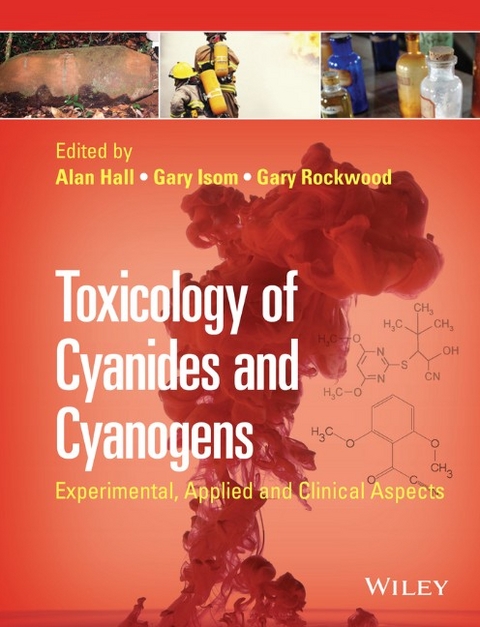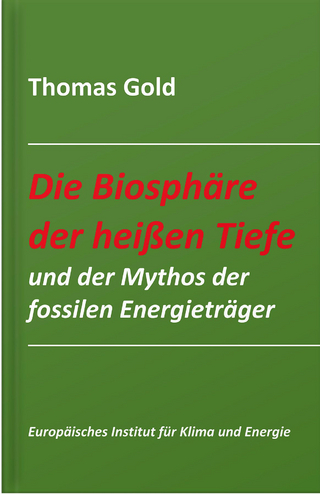
Toxicology of Cyanides and Cyanogens
Wiley-Blackwell (Verlag)
978-1-119-97853-4 (ISBN)
- Titel z.Zt. nicht lieferbar
- Versandkostenfrei
- Auch auf Rechnung
- Artikel merken
Alan H. Hall Toxicology Consulting and Medical Translating Services, Inc., USA Department of Health & Human Services, Colorado School of Public Health, USA Gary E. Isom Department of Pharmacology and Toxicology, Purdue University, USA Gary A. Rockwood Analytical Toxicology Division, United States Army Medical Research Institute of Chemical Defense, USA
List of Contributors xv
Foreword xix
1 Acute cyanide toxicity 1
Andrea R. Allen, Lamont Booker, and Gary A. Rockwood
1.1 Introduction 1
1.2 Pharmacokinetic properties of cyanide 2
1.3 Pharmacodynamic properties of cyanide 4
1.4 Acute cyanide toxicity – routes of administration 5
1.5 Neurological and behavioral effects following acute cyanide exposure 12
1.6 Summary 14
References 14
2 Chronic cyanide exposure 21
Jason D. Downey, Kelly A. Basi, Margaret R. DeFreytas, and Gary A. Rockwood
2.1 Introduction 21
2.2 Sources of chronic cyanide exposure 21
2.3 Chronic cyanide exposure in human disease 23
2.4 Experimental models of chronic cyanide exposure 30
2.5 Conclusion 35
References 36
3 Physicochemical properties synthesis applications and transport 41
David E. Thompson and Ilona Petrikovics
3.1 Introduction 41
3.2 Natural sources of cyanide 41
3.3 Isolation and characterization of cyanide 43
3.4 Industrial production of cyanide 44
3.5 Applications and uses of cyanide 46
Acknowledgments 50
References 50
4 Cyanide metabolism and physiological disposition 54
Gary E. Isom, Joseph L. Borowitz, and Alan H. Hall
4.1 Introduction 54
4.2 Metabolism and toxicokinetics 55
4.3 Non-enzymatic detoxification of cyanide 63
4.4 Diseases associated with altered cyanide metabolism 64
4.5 Metabolism and endogenous generation of cyanide 65
References 65
5 Biochemical mechanisms of cyanide toxicity 70
Gary E. Isom and Joseph L. Borowitz
5.1 Introduction 70
5.2 Cytochrome oxidase inhibition and mitochondrial dysfunction 72
5.3 Oxidative stress and inhibition of cellular oxidative defense 75
5.4 Cyanide-induced changes in cellular Ca2+ regulation 76
5.5 Cyanide-induced cell death and post-intoxication lesions 77
5.6 Alteration of intermediary metabolism and lactic acidosis 78
5.7 Conclusion 78
References 79
6 Environmental toxicology of cyanide 82
Samantha L. Malone, Linda L. Pearce, and Jim Peterson
6.1 Introduction 82
6.2 Environmentally relevant chemistry of cyanides 83
6.3 Occupational concerns 87
6.4 Ground/surface water 87
6.5 Exposure to cyanogens through diet 89
6.6 Dietary health hazards 89
6.7 Cassava consumption 90
6.8 Fires and smoke 91
6.9 Conclusion 92
References 93
7 Cyanide in the production of long-term adverse health effects in humans 98
Julie Cliff, Hipolito Nzwalo, and Humberto Muquingue
7.1 Introduction 98
7.2 Long-term adverse health effects 100
7.3 Conclusions 107
References 107
8 Pediatric cyanide poisoning 113
Robert J. Geller
8.1 Introduction 113
8.2 Sources of acute cyanide poisoning in children 114
8.3 Manifestations of acute cyanide poisoning 122
8.4 Cyanide antidotes 124
8.5 Conclusion 126
References 126
9 Sodium nitroprusside in intensive care medicine and issues of cyanide poisoning cyanide poisoning prophylaxis and thiocyanate poisoning 129
Prasad Abraham, Alissa Lockwood, John Patka, Marina Rabinovich, Jennifer Sutherland, and Katleen Chester
9.1 Introduction 129
9.2 History 129
9.3 Mechanism of action 130
9.4 Metabolism 130
9.5 Evidence for CN− toxicity associated with SNP 132
9.6 Incidence of CN− toxicity 134
9.7 Challenges associated with CN−monitoring 140
9.8 Safe use of SNP – clinical monitoring 141
9.9 Prevention and treatment of CN−toxicity 142
9.10 Conclusions 146
9.11 Disclosure 146
References 146
10 Smoke inhalation 151
Alan H. Hall and Stephen W. Borron
10.1 Introduction 151
10.2 Cyanide in smoke inhalation 152
10.3 Plasma lactate levels as a screening assay 154
10.4 Exhaled breath cyanide meters 154
10.5 Cobinamide colorimetric quantitative/qualitative blood cyanide measurements 154
10.6 Additional information 154
References 156
11 Occupational exposure to cyanide 158
Tee L. Guidotti
11.1 Introduction 158
11.2 Firefighters 159
11.3 Hazmat and counter-terrorism 161
11.4 Other occupations 162
11.5 Illicit operations using cyanide 163
References 164
12 Cyanogenic aliphatic nitriles 166
Stephen W. Borron
12.1 Overview 166
12.2 Toxicology 166
12.3 Case reports of human toxicity of specific nitriles 172
12.4 Antidotal treatment 178
12.5 Summary 179
Acknowledgments 179
References 179
13 The special case of acrylonitrile (CH2=CH–C≡N) 181
Dana B. Mirkin
13.1 Introduction – clinical vignettes 181
13.2 Physical and chemical properties 182
13.3 History – preparation – manufacture 182
13.4 Occurrence 183
13.5 Compounds and uses 183
13.6 Hazardous exposures 184
13.7 Toxicokinetics 184
13.8 Mode of action 185
13.9 Clinical effects 186
13.10 Diagnosis – toxicity 189
13.11 Treatment – antidote 190
13.12 Biological monitoring 191
13.13 Exposure limits 191
References 192
14 Cyanide in chemical warfare and terrorism 195
René Pita
14.1 Cyanides as chemical warfare agents 195
14.2 Cyanide and chemical terrorism 200
14.3 Conclusions 206
References 206
15 Cyanide-induced neural dysfunction and neurodegeneration 209
Gary E. Isom and Joseph L. Borowitz
15.1 Introduction 209
15.2 Cyanide exposure and manifestations of toxicity 210
15.3 Cyanide-induced histotoxic hypoxia and metabolic dysfunction 210
15.4 Neurochemical actions of cyanide in the nervous system 212
15.5 Cyanide-induced brain injury and neurodegeneration 214
15.6 Endogenous cyanide generation in CNS 215
15.7 Cyanide-induced neurological disorders 216
15.8 Conclusion 220
References 220
16 Cyanides and cardiotoxicity 224
J.-L. Fortin, T. Desmettre, P. Luporsi, and G. Capellier
16.1 Introduction 224
16.2 Physiopathology 224
16.3 Clinical aspects 226
16.4 Treatment 228
16.5 Conclusion 230
References 230
17 Respiratory effects of cyanide 232
A. Eisenkraft, A. Falk, and Y. Bentur
17.1 Background 232
17.2 Mechanisms of the respiratory effects of cyanide 233
17.3 Clinical manifestations and animal studies 238
17.4 Management of cyanide poisoning and its respiratory effects 241
17.5 Conclusion 245
References 245
18 The analysis of cyanide in biological samples 249
Brian A. Logue and Brendan L. Mitchell
18.1 Introduction 249
18.2 Biological matrices 249
18.3 Sample storage 251
18.4 Sample preparation 251
18.5 Spectroscopy 252
18.6 Gas chromatography 254
18.7 High-performance liquid chromatography 256
18.8 Capillary electrophoresis 257
18.9 Electrochemical methods 258
18.10 Sensors 258
18.11 Cyanide metabolites 260
18.12 Insights on cyanide analysis 260
References 260
19 Postmortem pathological and biochemical diagnosis of cyanide poisoning 268
Daniel Lugassy and Lewis Nelson
19.1 Introduction 268
19.2 Cyanide pathology and antemortem presentation 268
19.3 Exposures 269
19.4 Autopsy features 269
19.5 Biochemical analysis 271
19.6 Risk to autopsy staff 273
References 274
Further reading 275
20 Medicolegal and forensic factors in cyanide poisoning 276
Jorn Chi-Chung Yu and Ashraf Mozayani
20.1 Introduction 276
20.2 Forensic practice for the investigation of cyanide poisoning 277
20.3 Discussion 278
20.4 Conclusion 280
References 280
21 Brief overview of mechanisms of cyanide antagonism and cyanide antidotes in current clinical use 283
Alan H. Hall
21.1 Introduction 283
21.2 Methemoglobin inducers 283
21.3 Sulfur donors 285
21.4 Direct cyanide chelating agents 285
21.5 Conclusion 286
References 286
22 Cyanide antidotes in clinical use: 4-dimethylaminophenol (4-DMAP) 288
Alan H. Hall
22.1 Introduction 288
22.2 Mechanism of action 288
22.3 Experimental data 289
22.4 Published clinical data 289
22.5 Adverse/side effects 290
22.6 Conclusions 291
References 291
23 Cyanide antidotes in clinical use: dicobalt EDTA (Kelocyanor®) 292
Alan H. Hall
23.1 Introduction 292
23.2 Mechanism of action 292
23.3 Experimental data 293
23.4 Published clinical data 293
23.5 Adverse/side effects 294
23.6 Conclusions 294
References 294
24 Amyl nitrite sodium nitrite and sodium thiosulfate 296
Richard J. Geller
24.1 History and chemistry 296
24.2 Theoretical bases for use/mechanism of action 297
24.3 Pharmacokinetics 299
24.4 How supplied 299
24.5 Indication and dosing of intravenous antidotes 300
24.6 Adverse effects 301
24.7 Conclusions 301
References 301
25 Cyanide antidotes in current clinical use: hydroxocobalamin 304
Alan H. Hall and Stephen W. Borron
25.1 Background and historical perspective 304
25.2 Pharmacology 305
25.3 Experimental animal studies 306
25.4 Human experience 306
25.5 Dosage and route of administration 306
25.6 Adverse effects 306
25.7 Laboratory interferences 307
25.8 Comparison with other antidotes 307
25.9 Conclusion 307
References 307
26 Cyanide antidotes in development and new methods to monitor cyanide toxicity 309
Matthew Brenner, Sari Mahon-Brenner, Steven E. Patterson, Gary A. Rockwood, and Gerry R. Boss
26.1 Introduction 309
26.2 Cobinamide and sulfanegen 310
26.3 Other cyanide antidotes in development 313
26.4 New research methods to diagnose and monitor cyanide poisoning and therapy 313
26.5 Conclusions 316
References 316
27 Recent perspectives on alpha-ketoglutarate 317
R. Bhattacharya
27.1 Introduction 317
27.2 Cyanide toxicity and its treatment 318
27.3 A-KG as a cyanide antidote 318
27.4 The need for an oral antidote 321
27.5 A-KG as an oral antidote 321
27.6 Some key functions of A-KG 323
27.7 Efficacy of A-KG against other toxins 324
27.8 Role of A-KG as a nutritional supplement 324
27.9 Conclusion 325
Acknowledgments 325
References 325
28 Azide poisonings 330
Thomas L. Kurt and Wendy Klein-Schwartz
28.1 Introduction 330
28.2 Lack of cyanide antidote efficacy 331
28.3 Uses of sodium azide 331
28.4 Review of reported sodium azide human poisoning cases 331
28.5 Human experimental exposures to sodium azide and hydrazoic acid 332
28.6 Signs and symptoms 332
28.7 Fatal cases 332
28.8 Historical perspective 333
28.9 Mechanism(s) of action 333
28.10 Autopsy findings 333
28.11 Other outcomes 333
28.12 Occupational health issues 333
28.13 Occupational/environmental exposure limits/recommendations 334
28.14 Laboratory evaluation 334
28.15 Conclusion 334
Acknowledgments 334
Conflict of interest 334
References 334
Index 337
| Erscheint lt. Verlag | 14.12.2015 |
|---|---|
| Verlagsort | Hoboken |
| Sprache | englisch |
| Maße | 193 x 254 mm |
| Gewicht | 785 g |
| Themenwelt | Naturwissenschaften ► Biologie ► Biochemie |
| Naturwissenschaften ► Chemie ► Anorganische Chemie | |
| ISBN-10 | 1-119-97853-X / 111997853X |
| ISBN-13 | 978-1-119-97853-4 / 9781119978534 |
| Zustand | Neuware |
| Informationen gemäß Produktsicherheitsverordnung (GPSR) | |
| Haben Sie eine Frage zum Produkt? |
aus dem Bereich


